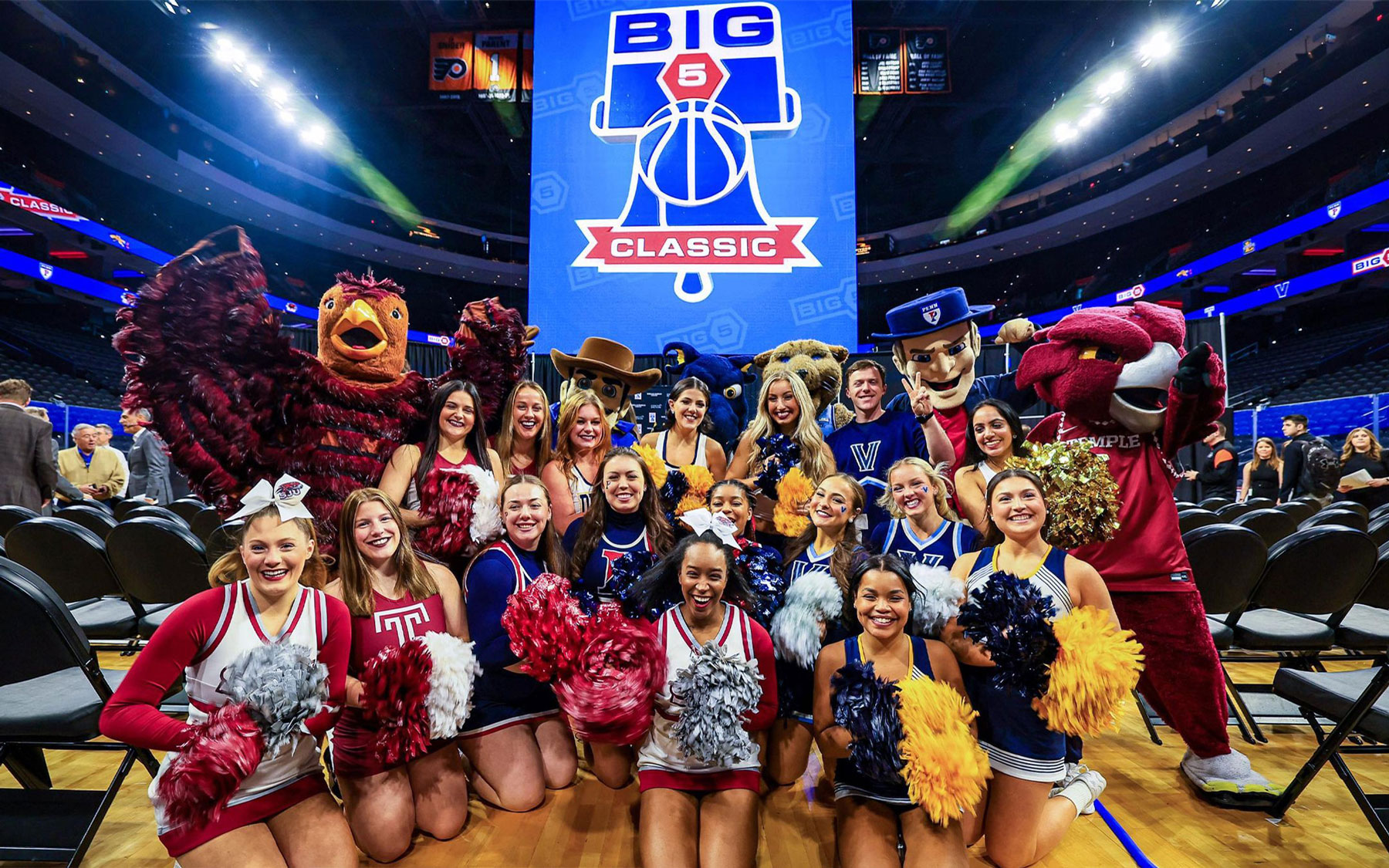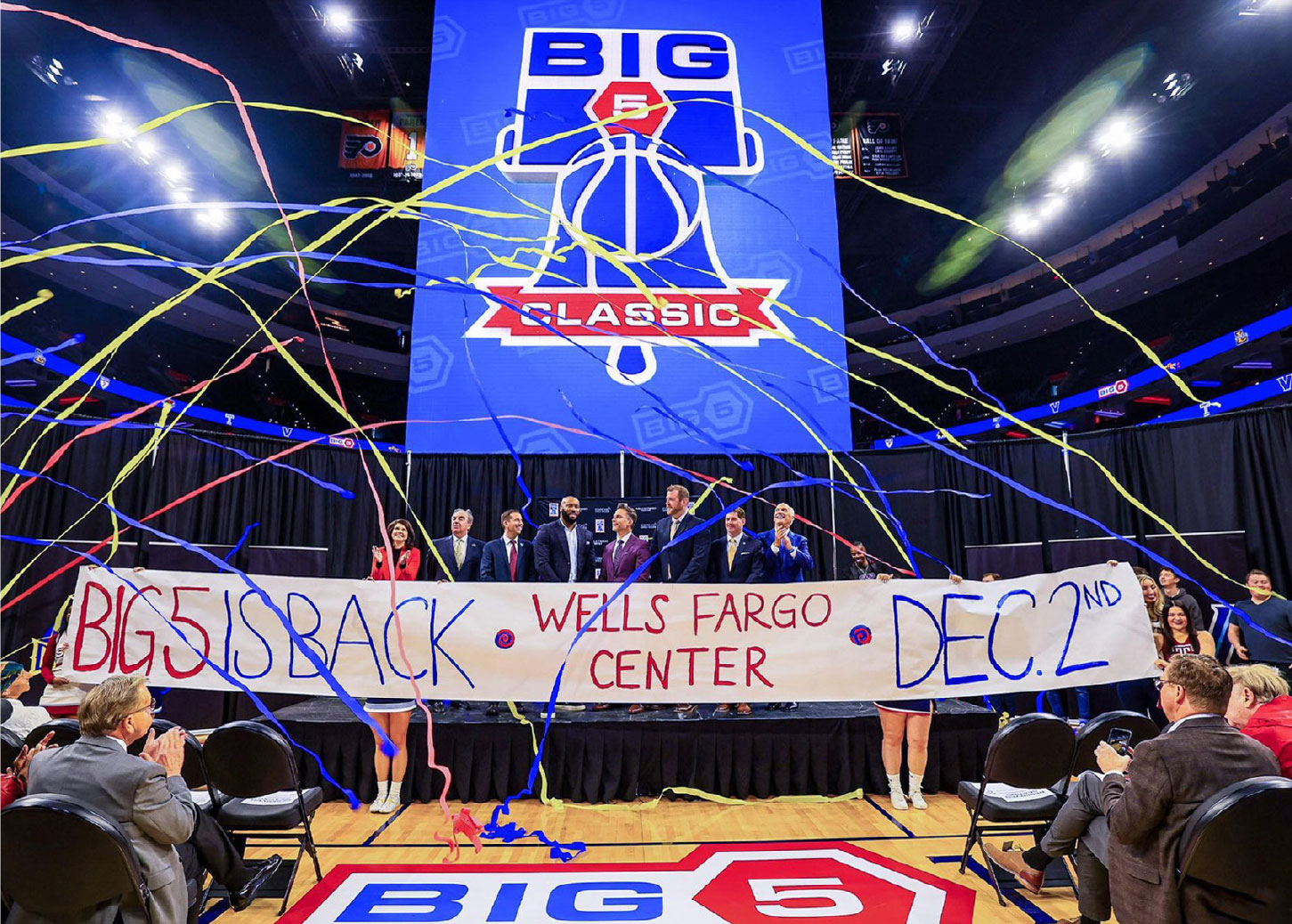
Cheerleaders, mascots and pompoms, oh my!

Men’s basketball coach Zach Spiker addresses the media.
For years, there was something odd about one of college basketball’s biggest brands: The Big 5. The storied alliance of Philadelphia-area schools conspicuously lacked the sixth major university in town.
Happily, that omission was rectified in April when the group — comprised of La Salle, the University of Pennsylvania, St. Joseph’s, Temple and Villanova — officially welcomed Drexel into the fold.
For Drexel basketball fans, the university’s inclusion in the renowned Big 5 is an exhilarating milestone that elevates the team to compete alongside Philadelphia’s finest and marks a momentous step toward national recognition.
“Drexel has, over the decades, positioned itself in a prominent place in Philadelphia,” Director of Athletics Maisha Kelly says. “It’s appropriate that basketball, which is a premier sport for our department, is also in that same position. This is about associating our brand with the best, and that’s what the Big 5 has represented in basketball. One of the things I often talk about is that we want to tell Drexel’s story. This is another platform that we get to do it on. We are proud to have the opportunity to talk about what it means to be a Drexel student-athlete, and our university.”
The Big 5 name won’t change, but its marquee events — tournaments pitting its men’s and women’s basketball teams against one another — will. In December, the Big 5 men’s champion will be crowned after a triple-header at the Wells Fargo Center. For the new series, the six schools will be separated into three-team pods (Drexel, Temple and La Salle in one; Villanova, St. Joe’s and Penn in the other). Each team will play the other two teams from its pod at on-campus arenas. All of the teams will participate in the Big 5 Classic triple-header at the Wells Fargo Center on Dec. 2, with the first seed in each pod competing for the championship, the second-place teams in each pod playing for third place, and the third seeds vying for fifth place.

“We’re excited for the opportunity to compete against these great schools every year.”
— Zach Spiker

Alumni and fans celebrate with coaches.
A revamped format for the women’s basketball programs is still being worked out and will debut in the 2024–25 season, Kelly says.
Founded in 1955, the Big 5 is not a conference, but rather a grouping of schools that compete for what is essentially the most important city crown in college basketball. Three trophies were awarded that first season: one for the team with the best record against the other four, presented by the Philadelphia Inquirer; one for the player “best typifying the qualities of sportsmanship, scholarship and leadership,” handed out by the Food Fair grocery chain; and one from the Philadelphia Screenwriters’ Association to the most valuable player.
“The Big 5 brand has been known by anybody who’s connected to college basketball,” men’s basketball coach Zach Spiker says. “It’s synonymous with some of the best basketball in the country. For Drexel to be included in such a prestigious group is a tremendous honor and we take it very seriously. We’re excited for the opportunity to compete against these great schools every year.”
Discussions on admitting Drexel heated up beginning about two years ago, Kelly says. But Drexel has played Big 5 schools for decades. When Drexel basketball Hall of Fame player Michael Thompson ’92 arrived on campus from his home in the Bronx in the late ’80s, he was already familiar with the Big 5, which for much of its history held many of its most important games at the legendary Palestra on Penn’s campus.

The Wells Fargo Center is the league’s new home.
“My first college game was against St. Joe’s at the Palestra,” he says. “I’m a kid from New York and I think Philadelphia is arguably the best college basketball town in America, with the tradition, all the players and coaches, and certainly an edifice like the Palestra.”
The new primary venue for the Big 5 will be the Wells Fargo Center, home of the NBA’s Philadelphia 76’ers. The arena, which is undergoing a $350 million transformation, has been the site of numerous NCAA Tournament games, including the NCAA men’s east regionals (twice), NCAA men’s first and second round games (three times), and the 2000 NCAA Women’s Final Four. It is scheduled to host NCAA men’s first and second round games in 2026. Playing there will be a thrill for players and coaches alike. Drexel hasn’t taken the court there since Spiker took over as coach in 2016.
“When you can tell the story to prospective student-athletes, or experience it as a current student-athlete or a coach, that you are competing in an NBA arena, that is certainly an opportunity that is valued,” Kelly says. “We look forward to making this a signature event for our university.”
In addition to the prestige of Big 5 membership, both the men’s and women’s teams will gain annual opponents from competitive conferences including the Big East, Atlantic 10 and American Athletic. It’s a major step up for Spiker’s program, which is one of only five in the country that didn’t have a player enter the transfer portal after last season.
“We have built a culture where guys want to be at Drexel,” Spiker says. “We’ve added one player as a graduate transfer and one freshman, but the remaining 12 players are returning. It’s an honor to coach the group that we have, and we’re excited that this is the year we have the opportunity to go into the Big 5.”
Support Drexel’s student athletes


